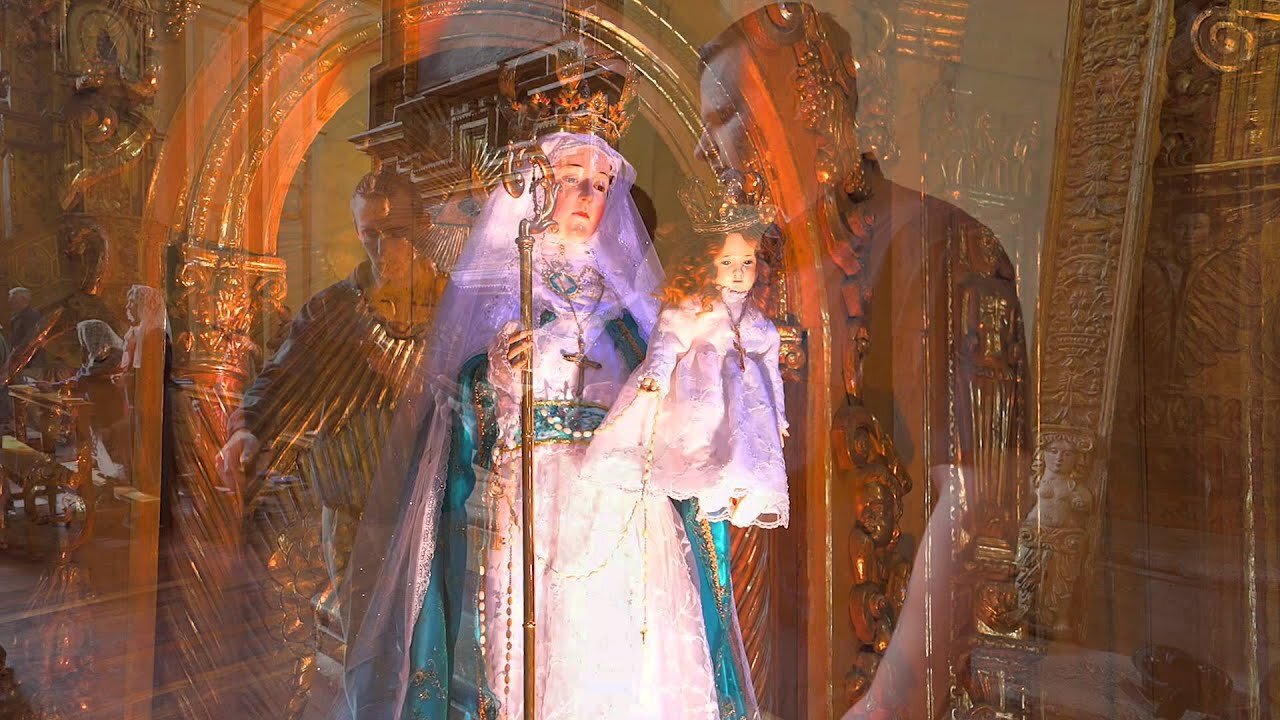Premium Only Content

Salve Regina (Solemn Tone) Sacred Music-Quito Pilgrimage
+J.M.J.+ Dedicated to Our Beloved Heavenly Mother Mary. This particular Gregorian Chant can be found in the 1962 Liber Usualis- page 276 and is our version of the Solemn Tone Salve Regina. After achieving our version of this chant, someone asked us what “harmonization" technique was used. We asked a very good friend to help us explain and he provided this info:
Gregorian Chant is monophonic ("single-voiced). Harmony can only arise with a plurality of voices each singing different but complimentary notes. Gregorian Chant does not have harmony written into its various compositions as found in the liturgical texts, but you can certainly harmonize with Gregorian Chant. You can harmonize with any choral form. Harmonizing with Gregorian Chant through the use of a prolonged single note is typically referred to as a "drone". The Byzantine tradition refers to this note as an "ison". This ison can remain fixed on a single note within the Do-scale of Gregorian Chant or it can go up and down at certain points within the main melody. This is referred to as "modulating". Additionally, the choosing of a particular note for an ison is largely based on the various tones that are assigned to a certain piece of Gregorian Chant (the mode number is typically written next to the first portion of the chant's staff). Below is a handy table which shows which ison is assigned to each mode:
Mode Ison Final Dominant Range Mood
I Re (or do with mi/sol) Re La re-re Gravis
II La (or re/do) Re Fa (or La) la-la Tristis
III Mi Mi Ti mi-mi Mysticus
IV La Mi La ti-ti Harmonicus
V Fa and Do Fa Do fa-fa Laetus
VI Fa Fa La do-do Devotus
VII Sol Sol Re sol-sol Angelicus
VIII Sol Sol Do re-re Perfectus
Further complexity can be added in several ways. One way is to incorporate several isons/drones that harmonize both with each other and the Gregorian melody. Another way is to sing the Gregorian melody at a different musical interval (i.e. a 5th, Major 3rd, etc.). The latter is typically referred to as Organum. Organum differs from an ison in that it maintains the same tempo and melody of the Gregorian Chant whereas an ison can be sung independently (although even an ison is dependent upon the melody of the Chant in order to achieve a proper harmony).
While in Quito, Ecuador, to attend the Feast of Mary of Buen Suceso of the Purification, Feb. 2nd., Fr. Michael Rodríguez offered daily Traditional Latin Mass in the Conceptionist Church & Convent--home of Mary of Buen Suceso of the Purification. The technical name of the Church is, "Iglesia de La Limpia Concepcion". This first monastery in Quito was established in September of 1575.
The miraculous statue of Mary of Buen Suceso of the Purification is taken from the cloistered upper choir three times a year and placed above the main altar of the Convent Church so that it can be venerated by the public.
Fr. Rodriguez also led pilgrims daily in praying the Holy Rosary and Novena to Mary of Buen Suceso of the Purification in front of the miraculous statue and gave spiritual conferences every evening on the major themes of Grace, Jesus Christ, and the Blessed Virgin Mary. Blessed be Jesus Christ and His most pure Mother!
More on Mary of Buen Suceso of the Purification:
Mary of Buen Suceso of the Purification appeared to a Conceptionist nun, Venerable Mariana de Jesús Torres (1563–1635), in Quito, Ecuador, who was allowed to see what would occur in the 20th century and therefore offered her life and sufferings for the crisis within the Church. Mother Mariana de Jesús Torres was bestowed with many singular gifts from heaven and received numerous prophecies of the future, especially in the 20th century. Many are amazed at how accurate Our Lady's predictions for the 20th century have been.
Mary of Buen Suceso of the Purification commanded that a statue be made. In her right hand, she carries a Crosier as Abbess of the convent and Queen of Heaven and Earth. In her left arm, she carries her Divine Son so that "all will know that I am merciful and understanding. Let them come to me for I will lead them to Him." The statue was completed miraculously by the Archangels Michael, Gabriel, Raphael, and Saint Francis of Assisi.
Many people have never heard of her message, apparitions or prophecies. Yet she is a powerful complement to the Message of Our Lady of Fatima (1917) and indispensable for understanding what is taking place in our own time (20th/21st century).
Learn more about Mary of Buen Suceso of the Purification on these sites:
http://jmjhfproductions.weebly.com/quito-ecuador.html
http://www.ourladyofgoodsuccess.com/
https://svfonline.org/product/the-mystery-of-grace-mary-brings-us-the-life-of-christ/
Why Buen Suceso Instead Of Good Success? https://youtu.be/Lg8VVG5sODA
Monthly Tridentine Masses are offered for all our benefactors who are also remembered in our daily prayers. Deo grátias! Thank you!
Please visit our GoFundMe page; https://www.gofundme.com/f/bpq7mo
—or—
To help defray the cost of making these videos possible, please consider donating on our website: http://jmjhfproductions.weebly.com/
—or—
Donations can be sent to:
St. Vincent Ferrer Foundation
3155 David Ct.
Edgewood, KY 41017
Phone: (915) 541-5853
Email: info@svfonline.org
Website: http://svfonline.org/
Please indicate that donations are for support of the JMJ HF videos. The Foundation is a 501(c)(3) Non-profit Corporation. You will receive a receipt for your donation.
-
 12:13
12:13
JMJ HF Productions
1 year agoChant Propers-Votive Mass of The Sacred Heart of Jesus (Septuagesima to Easter) outside Eastertide
2472 -
 17:53
17:53
Fit'n Fire
18 hours ago $1.56 earnedA Rifle for the Family -- BCM MK2 BFH and Gunnr Optics Odin 1-10x28mm LPVO
13.9K2 -
 1:03:52
1:03:52
GrassRootsWarriorNetwork
1 month agoWe The People Are The News Now While MSM Is On It’s Way Out - YourNews.com with Sam Anthony
13.6K -
 21:12
21:12
DeVory Darkins
13 hours ago $17.21 earnedGavin Newsom gets what he deserves after NBC Reporter FACT CHECKS his Lies
60.2K57 -
 1:57:13
1:57:13
MyronGainesX
13 hours agoFormer Fed Explains Sting That Led To The Murder Of A State Trooper
81.7K20 -
 3:56:27
3:56:27
Due Dissidence
19 hours agoNewsom ROASTED For Pod Save Interview, Candace Owens CALLS OUT Elon, Ian Carroll RATIOES Israel Post
76.5K53 -
 2:16:17
2:16:17
TheSaltyCracker
11 hours agoLooters Descend on LA ReeEEeE Stream 01-12-25
150K318 -
 40:32
40:32
Man in America
16 hours agoRockefeller Medicine COLLAPSES as God's Natural Healing Takes Over w/ Angie Tomky
54.3K35 -
 2:03:30
2:03:30
Nerdrotic
13 hours ago $7.13 earnedMysteries of Egypt with The Brothers of the Serpent | Forbidden Frontier #087
54.9K3 -
 2:29:27
2:29:27
vivafrei
21 hours agoEp. 245: Los Angeles ON FIRE! Gavin Newsom FOR JAIL? Trump SENTENCED! Pardons & MORE! VIva & Barnes
206K314